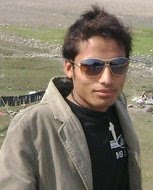Black holes are the remaining part of star after its death. In the life cycle of star, there is a constant nuclear fusion at its core which generates photons through electromagnetic radiations. The radiation is responsible for the outward pressure that perfectly balances the pull of gravity from the mass of the star. But at the far end of the star’s life, when the nuclear fuel of the star starts diminishing, the outward pressure starts to reduce. Consequently, the inward gravitational pull increases manifold, thereby shrinking the star inward. Eventually, the core of the star collapses and becomes a black hole.
According to Einstein’s theory of relativity, the object falling to the surface of black does not appear ever and never comes out from the black hole, not even the light. Its gravity is so powerful and intense that even time stops in the black hole. The mass and size of the black hole are directly proportional to each other. For instance, if one black hole is 10 times heavier than other black hole, its radius also ought to be 10 times larger than the other. In fact, if there is a black hole with a mass equivalent to Sun, it will have a radius of 3 kilometers only! The radius of this event horizon is also known as the Schwarzschild radius which can be calculated by the formula:
:: r=2GM/c2 (where G: gravitational force, M: mass and c: speed of light or escape velocity)
The black hole contains two sections: event horizon and singularity. The event horizon is the surface of the black hole and the singularity signifies the core of the black hole. Anything needs to be in the vicinity of the event horizon to get sucked in. Event horizon is also called “point of no return”. Singularity is the sole of suction where the volume is zero and density is maximum. This is the point of infinite spacetime curvature. With time, the black holes keep shrinking in size as they constantly emit X-ray radiations constantly. After some while, they nearly evaporate.
The stars which are 10-15 times bigger than sun only can transform into a black hole. Smaller stars than sun become white dwarfs. Any body, to escape form the black hole is impossible, because the body must have greater velocity than light to escape from the black hole which is not possible till today. There have been a lot of researches ongoing in context of black hole. NASA has established a space telescope, which helps to detect and see the black hole, named as XMM-Newton. This telescope can observe the universe in light containing high energy X-rays that are mostly emissions of black holes, which have also helped scientists a great deal in unraveling facts about the black holes in space. Due to the telescope, the scientists had the experienced the view of the entire process of a star being sucked into the black hole.
 Radi Kaiof tests the ReWalk. The inventor of ReWalk, Israeli engineer Amit Goffer, learned the hard way that wheelchair mobility is terribly outdated. In 1997, he broke his neck as the result of a fall, and the wheelchair's limitations were experienced by Goffer first hand. He set to work on a design for a wearable exoskeleten, kind of like a battery powered suit of armor for the lower body.
Radi Kaiof tests the ReWalk. The inventor of ReWalk, Israeli engineer Amit Goffer, learned the hard way that wheelchair mobility is terribly outdated. In 1997, he broke his neck as the result of a fall, and the wheelchair's limitations were experienced by Goffer first hand. He set to work on a design for a wearable exoskeleten, kind of like a battery powered suit of armor for the lower body.  The ReWalk is more complicated than it looks. Its 44 pounds of off-the-shelf components are controlled by hundreds of algorithms and codes and sensors that all enable standing, sitting, walking, and even climbing stairs. Radi Kaiof, a ReWalk tester had not walked in 20 years, but when he's strapped into the ReWalk, he's a different man.
The ReWalk is more complicated than it looks. Its 44 pounds of off-the-shelf components are controlled by hundreds of algorithms and codes and sensors that all enable standing, sitting, walking, and even climbing stairs. Radi Kaiof, a ReWalk tester had not walked in 20 years, but when he's strapped into the ReWalk, he's a different man.